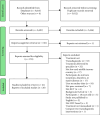Transdiagnostic Psychological Interventions for Symptoms of Common Mental Disorders Delivered by Non-Specialist Providers in Low- and Middle-Income Countries: A Systematic Review and Meta-Analysis
- PMID: 40226747
- PMCID: PMC11921846
- DOI: 10.1155/2024/5037662
Transdiagnostic Psychological Interventions for Symptoms of Common Mental Disorders Delivered by Non-Specialist Providers in Low- and Middle-Income Countries: A Systematic Review and Meta-Analysis
Abstract
There is a treatment gap for Common Mental Disorders (CMDs) such as anxiety, depression, and post-traumatic stress disorder (PTSD), as well as non-specific psychological distress (NPD) in low- and middle-income countries (LAMIC), due to the lack of available clinicians and locally appropriate interventions. Task-shifting using non-specialist providers (NSP) and transdiagnostic approaches may address this. Transdiagnostic approaches can be effective at treating CMDs and NPD in high-income countries (HIC), but currently, there is no comprehensive synthesis of evidence regarding their effectiveness in LAMICs. This review addressed this gap by examining the effectiveness of transdiagnostic psychological interventions for symptoms of CMDs and NPD delivered by NSPs in LAMICs. Three databases were searched (Embase, PsycInfo, and PubMed). Hedge's g's were calculated using random-effect models to correct for small sample bias. Twenty-one transdiagnostic interventions across 20 studies were included. Moderate reductions at posttreatment were found in psychological distress (g = -0.64; 95% CI: -0.81 to -0.46), symptoms of anxiety (g = -0.61; 95% CI: -0.80 to -0.42), depression (g = -0.59; 95% CI: -0.75 to -0.44), and PTSD/trauma (g = -0.38; 95% CI: -0.59 to -0.16), with significant small reductions maintained at follow-up ranging from 13 to 26 weeks for NPD (SMD = - 0.37; 95% CI: -0.57 to -0.17), anxiety (g = - 0.41; 95% CI: -0.91 to 0.09), depression (g = -0.38; 95% CI: -0.59 to -0.16), and trauma symptoms (g = -0.23; 95% CI: -0.42 to -0.05). These findings are important and suggest that transdiagnostic approaches delivered by NSPs are effective at treating symptoms of CMDs and NPD in LAMICs. Future research should consider comparing task-shifting approaches with disorder-specific interventions and explore the effectiveness of longer sessions across various mental health conditions.
Copyright © 2024 Éanna Ó hAnrachtaigh et al.
Conflict of interest statement
The authors declare that they have no conflicts of interest.
Figures














Similar articles
-
Psychological interventions for common mental disorders in women experiencing intimate partner violence in low-income and middle-income countries: a systematic review and meta-analysis.Lancet Psychiatry. 2020 Feb;7(2):173-190. doi: 10.1016/S2215-0366(19)30510-3. Lancet Psychiatry. 2020. PMID: 31981539 Free PMC article.
-
Primary-level and community worker interventions for the prevention of mental disorders and the promotion of well-being in low- and middle-income countries.Cochrane Database Syst Rev. 2023 Oct 24;10(10):CD014722. doi: 10.1002/14651858.CD014722.pub2. Cochrane Database Syst Rev. 2023. PMID: 37873968 Free PMC article.
-
Interventions for adults with a history of complex traumatic events: the INCiTE mixed-methods systematic review.Health Technol Assess. 2020 Sep;24(43):1-312. doi: 10.3310/hta24430. Health Technol Assess. 2020. PMID: 32924926 Free PMC article.
-
Comparative effectiveness of psychological interventions for treating the psychological consequences of sexual abuse in children and adolescents: a network meta-analysis.Cochrane Database Syst Rev. 2023 Jun 5;6(6):CD013361. doi: 10.1002/14651858.CD013361.pub2. Cochrane Database Syst Rev. 2023. PMID: 37279309 Free PMC article. Review.
-
Psychological therapies for the treatment of post-traumatic stress disorder in children and adolescents (Review).Evid Based Child Health. 2013 May;8(3):1004-116. doi: 10.1002/ebch.1916. Evid Based Child Health. 2013. PMID: 23877914 Review.
Cited by
-
Mental Health Interventions for Young People Living With HIV/AIDS in Sub-Saharan Africa: A Systematic Review.AIDS Res Treat. 2025 May 1;2025:5323539. doi: 10.1155/arat/5323539. eCollection 2025. AIDS Res Treat. 2025. PMID: 40342493 Free PMC article. Review.
References
-
- National Collaborating Centre for Mental Health. Common Mental Health Disorders: Identification and Pathways to Care . Leicester (UK): British Psychological Society; 2011. - PubMed
-
- World Health Organisation. Other Common Mental Disorders: Global Health Estimates . Vol. 24. Geneva, Geneva: World Health Organization; 2017.
-
- GBD 2017 Disease and Injury Incidence and Prevalence Collaborators. Disease and Injury Incidence and Prevalence Collaborators. Global, regional, and national incidence, prevalence, and years lived with disability for 354 diseases and injuries for 195 countries and territories, 1990-2017: a systematic analysis for the Global Burden of Disease Study 2017. The Lancet . 2017;392(10159):1789–1858. 2018. - PMC - PubMed
-
- Faisal-Cury A., Ziebold C., de Rodrigues D.M. O., Matijasevich A. Depression underdiagnosis: prevalence and associated factors. A population-based study. Journal of Psychiatric Research . 2022;151:157–165. https://www.sciencedirect.com/science/article/pii/S002239562200228X . - PubMed
Publication types
MeSH terms
LinkOut - more resources
Full Text Sources
Medical
Miscellaneous

